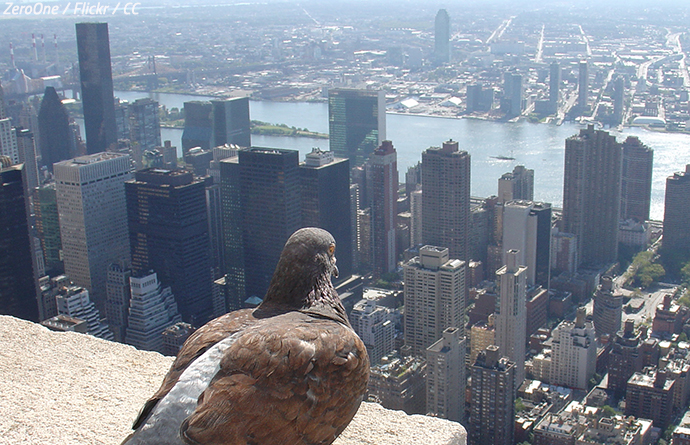Summary
Few animals are as synonymous with New York City as pigeons. These ubiquitous birds are found in parks, perched on building ledges, and strutting along sidewalks. Yet despite their resilience and adaptability, pigeons have earned a reputation as urban nuisances, often dismissed as “rats with wings.” This perception is far removed from the bird’s rich history and its once-celebrated relationship with humans. So how did pigeons, once revered and domesticated, fall so far in the eyes of New Yorkers?
Many people do not realize that the pigeon has a very long and important history with humans. Originally native to Europe, North Africa, and parts of Asia, these birds were domesticated thousands of years ago. Their remarkable homing ability made them invaluable messengers for ancient civilizations. Pigeons carried critical messages for the Romans, the Persians, and even during both World Wars. Their speed and reliability earned them the title of “war heroes” in times of conflict.
Pigeons also served as a vital food source. Known as “squab” when prepared for the table, pigeon meat has been considered a delicacy for centuries and remains so in parts of Europe, the Middle East, and Asia. Their utility and versatility made pigeons one of humanity’s most valuable avian companions.
How Pigeons Came to New York City
Pigeons were brought to North America by European settlers in the 1600s, primarily for food. Their adaptability and usefulness quickly made them a staple in colonial settlements, where they were raised both for sustenance and sport. Over time, the birds’ numbers grew, aided by their remarkable ability to thrive in urban environments that closely resembled their natural cliffside habitats. The abundance of tall buildings, ledges, and food scraps provided by humans allowed them to proliferate in cities like New York.

In the 19th century, pigeons played a significant role in New York City as both a food source and a pastime. Pigeon breeding and racing became popular hobbies among immigrant communities, particularly those from Italy and Ireland, who brought these traditions with them. Breeding specialized pigeons for competitions became a way to preserve cultural heritage, and rooftop pigeon coops became a common sight throughout the city, which ended up crossing all cultural barriers into predominantly black and Latino neighborhoods.
Beyond their recreational and culinary uses, pigeons also served New Yorkers in more practical ways. Their role as message carriers persisted into the early 20th century, and during World War I, pigeons raised in New York lofts were used in critical military operations. For many, these birds symbolized resilience and ingenuity, aligning with the city’s own spirit of survival and innovation.
What Do Pigeons Eat To Survive?
Pigeons in New York City have an omnivorous diet, thriving on a mix of natural and human-provided food sources. They eat grains, seeds, fruits, and small invertebrates when available, but the abundance of discarded food in urban environments has made them opportunistic feeders. Their adaptability to consuming almost anything edible is one of the reasons they’ve thrived in cities like New York.
This scavenging behavior, while key to their survival, has contributed to their reputation as nuisances, as they often congregate around garbage and food waste. Still, their ability to make use of limited resources in a bustling urban environment is a testament to their resilience and resourcefulness.
Why Pigeons Fell Out of Favor

In New York City, pigeons’ fall from grace began in the early 20th century. As technology allowed instant communication across borders for the first time in human history, the messenger service of the pigeon became outdated for the first time in thousands of years. Also, as cities grew and modern sanitation became a priority, pigeons were increasingly seen as pests. Their droppings, which can corrode buildings and spread diseases, earned them a reputation as dirty and destructive. Negative attitudes were further fueled by the rise of media sensationalism. The term “rats with wings” was popularized in the 1960s, reportedly coined by New York City parks commissioner Thomas Hoving, frustrated by the birds’ presence.
Once prized for their utility, pigeons were no longer needed for messaging or food in an era of modern communication and agriculture. Instead, they became synonymous with urban decay, seen as scavengers thriving off human waste. This disdain overshadowed their historical contributions and remarkable adaptability.
The Delicacy Few Remember
Despite their maligned reputation in New York, pigeons remain a delicacy in many parts of the world. Squab is a prized dish in French, Chinese, and Middle Eastern cuisines, valued for its tender meat and rich flavor. In rural areas, pigeons are still raised for food, carrying on a tradition that dates back millennia. Ironically, while many New Yorkers turn their noses up at these birds, they continue to hold culinary and cultural significance elsewhere.
The Reality of Getting Sick From Pigeons
Pigeons can carry diseases such as cryptococcosis, histoplasmosis, and psittacosis, which have the potential to infect humans. However, Pigeon-related diseases are very rare, and fatalities are uncommon. The New York City Department of Health indicates that while these diseases can be associated with pigeon droppings, the risk of infection is low. So much so, that they do not even keep records of such cases.
A Neighbor Worth Reconsidering
Pigeons’ bad rap in New York City is rooted more in perception than reality. While they can be messy and their ubiquity makes them easy targets for disdain, pigeons are also resilient, intelligent, and deeply tied to human history. They are survivors and deserve more respect than we give them.
We bred these animals for thousands of years to be dependent on us, then we turned our backs on them when we did not need them any more. Next time you see a pigeon, don’t feel guilty about throwing it some crumbs.
[Featured photo courtesy of Ville Saalo]

Eric is a 4th generation Lower East Sider, professional NYC history author, movie & TV consultant, and founder of Lower East Side History Project.

I love this! actually my roomate and i have argued about pigions and now i have the ammo to back up my stance haha.